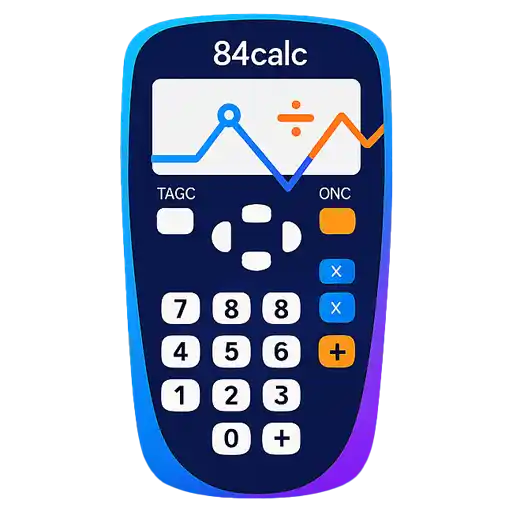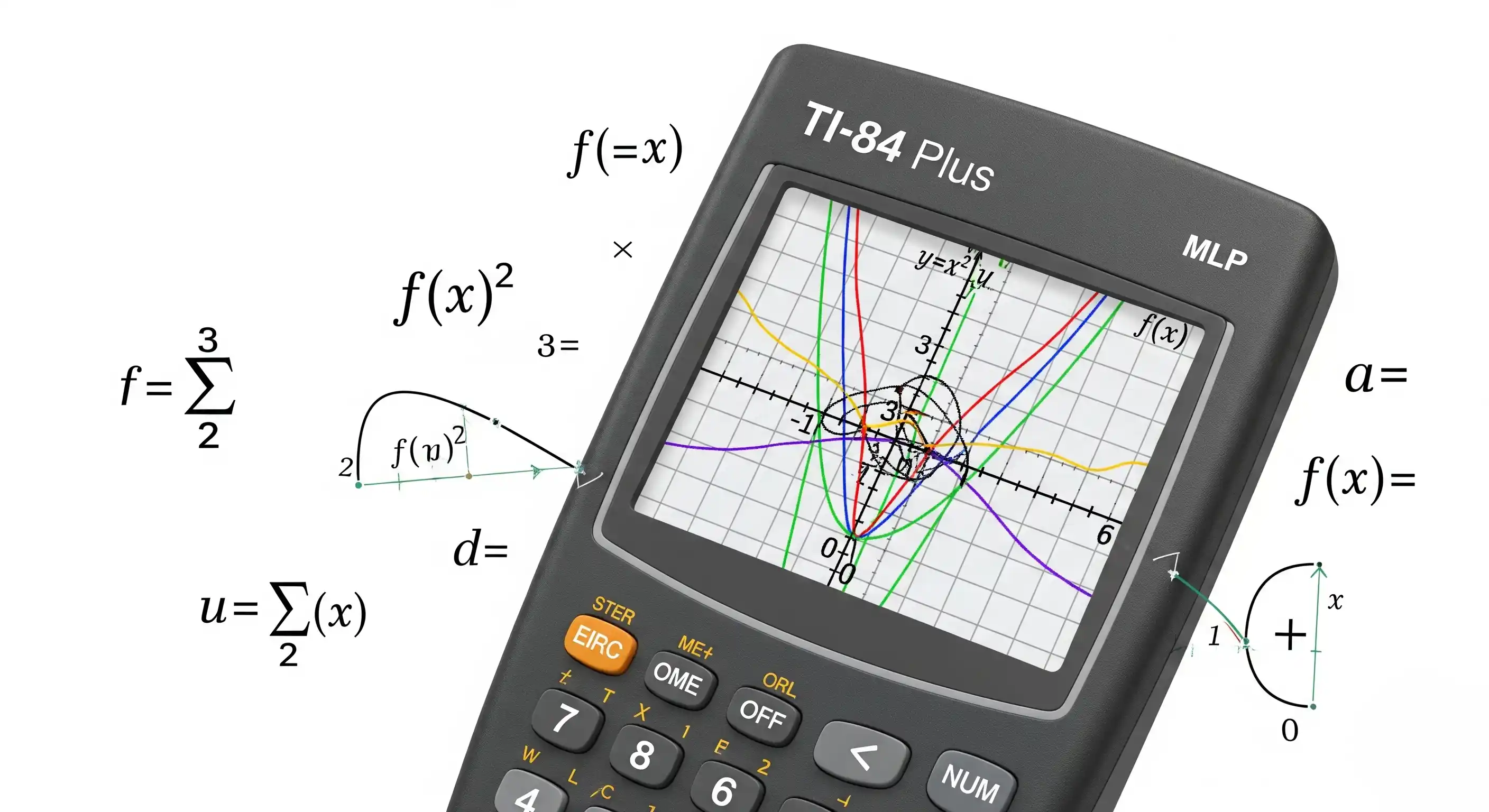Graphing functions is one of the most powerful features of your TI-84 Plus calculator. Whether you're visualizing linear equations, exploring quadratic functions, or analyzing complex trigonometric curves, mastering the graphing capabilities will enhance your understanding of mathematics and make problem-solving more intuitive.
This comprehensive tutorial will guide you through every aspect of function graphing on the TI-84 Plus, from basic setup to advanced techniques. You'll learn to create clear, accurate graphs and use them effectively for mathematical analysis.
📖 Table of Contents
- Getting Started: Basic Graphing Setup
- Graphing Linear Functions
- Graphing Quadratic Functions
- Graphing Trigonometric Functions
- Advanced Function Graphing
- Multiple Function Graphing
- Graph Analysis Tools
- ZOOM Functions
- Common Graphing Mistakes and Solutions
- Advanced Graphing Techniques
- Practical Applications
- Tips for Effective Graphing
Getting Started: Basic Graphing Setup
Before diving into specific function types, let's establish the fundamental steps for graphing any function on your TI-84 Plus calculator.
📈 Basic Graphing Steps:
- Press Y= to access the function editor
- Enter your function using proper syntax
- Press GRAPH to display the graph
- Use WINDOW to adjust the viewing area
- Use TRACE and ZOOM for analysis
Understanding the Y= Editor
The Y= editor is your command center for function graphing. Here's what you'll see:
- Y1, Y2, Y3... Function slots (up to 10 functions)
- = signs Indicate which functions are active for graphing
- Plot icons Different line styles and colors (on TI-84 Plus CE)
Y= Editor Screen:
\Y1=
\Y2=
\Y3=
\Y4=
\Y5=
\Y6=
Enter functions next to Y1, Y2, etc.
Graphing Linear Functions
Linear functions form the foundation of graphing skills. They create straight lines and follow the pattern y = mx + b.
📏 Linear Function Format: y = mx + b
- m: Slope (steepness and direction)
- b: Y-intercept (where line crosses y-axis)
- Examples: y = 2x + 3, y = -0.5x + 1, y = x
📊 Example 1: Graphing y = 2x - 3
Step-by-Step Process:
- Press Y=
- In Y1, enter: 2X-3
- Press GRAPH
- The calculator displays a straight line with slope 2
Linear function: y = 2x - 3 (slope = 2, y-intercept = -3)
Setting the Viewing Window
The WINDOW settings determine what portion of the coordinate plane you see:
Window Settings Explained:
- Xmin, Xmax: Horizontal viewing range
- Ymin, Ymax: Vertical viewing range
- Xscl, Yscl: Tick mark spacing on axes
- Xres: Graph resolution (1 = highest quality)
Standard Window Settings:
Xmin=-10
Xmax=10
Xscl=1
Ymin=-10
Ymax=10
Yscl=1
Xres=1
Standard viewing window: -10 to 10 on both axes
Graphing Quadratic Functions
Quadratic functions create parabolas (U-shaped curves) and follow the pattern y = ax² + bx + c.
📐 Quadratic Function Format: y = ax² + bx + c
- a: Determines parabola direction (positive = opens up, negative = opens down)
- b: Affects horizontal position and axis of symmetry
- c: Y-intercept (where parabola crosses y-axis)
- Examples: y = x², y = -2x² + 4x + 1, y = 0.5x² - 3x + 2
📊 Example 2: Graphing y = x² - 4x + 3
Step-by-Step Process:
- Press Y=
- Clear Y1 if needed, then enter: X²-4X+3
- Press GRAPH
- The parabola opens upward with vertex at (2, -1)
Quadratic function: y = x² - 4x + 3 (opens upward, vertex at (2, -1))
Finding Key Features of Parabolas
Use your calculator's analysis tools to find important points:
Finding Vertex and Intercepts:
- Vertex (minimum/maximum):
- Press 2nd + TRACE (CALC)
- Select "3:minimum" or "4:maximum"
- Use arrow keys to bracket the vertex
- Press ENTER three times
- X-intercepts (zeros):
- Press 2nd + TRACE (CALC)
- Select "2:zero"
- Bracket each zero individually
- Y-intercept:
- Look where the graph crosses the y-axis
- Or substitute x = 0 into the function
Graphing Trigonometric Functions
Trigonometric functions create wave patterns and are essential for modeling periodic phenomena.
🌊 Sine Function: y = sin(x)
- Domain: All real numbers
- Range: [-1, 1]
- Period: 2π (≈ 6.28)
- Key points: (0,0), (π/2,1), (π,0), (3π/2,-1), (2π,0)
🌊 Cosine Function: y = cos(x)
- Domain: All real numbers
- Range: [-1, 1]
- Period: 2π (≈ 6.28)
- Key points: (0,1), (π/2,0), (π,-1), (3π/2,0), (2π,1)
📐 Tangent Function: y = tan(x)
- Domain: All real numbers except π/2 + nπ
- Range: All real numbers
- Period: π (≈ 3.14)
- Vertical asymptotes: x = π/2, 3π/2, etc.
📊 Example 3: Graphing y = sin(x)
Step-by-Step Process:
- Press Y=
- In Y1, enter: SIN(X)
- Press ZOOM → 7:ZTrig for proper trig window
- Press GRAPH to see the sine wave
Sine function: y = sin(x) showing one complete period
💡 Angle Mode Setting
Check your angle mode! Press MODE and ensure you're in the correct setting:
- Radian: For calculus and advanced math (most common)
- Degree: For basic trigonometry and real-world applications
Advanced Function Graphing
Graphing Absolute Value Functions
Absolute value functions create V-shaped graphs:
📊 Example 4: Graphing y = |x - 2| + 1
Steps:
- Press Y=
- Enter: MATH → NUM → 1:abs(
- Complete: abs(X-2)+1
- Press GRAPH
Result: V-shaped graph with vertex at (2, 1)
Graphing Exponential Functions
Exponential functions show rapid growth or decay:
📈 Exponential Function Types:
- Growth: y = a·bˣ where b > 1 (e.g., y = 2ˣ)
- Decay: y = a·bˣ where 0 < b < 1 (e.g., y = (1/2)ˣ)
- Natural exponential: y = eˣ (use 2nd + LN)
Graphing Logarithmic Functions
Logarithmic functions are the inverse of exponential functions:
Common Logarithmic Functions:
- Common log: y = log(x) using LOG key
- Natural log: y = ln(x) using LN key
- Custom base: y = log_b(x) = ln(x)/ln(b)
Multiple Function Graphing
Your TI-84 Plus can graph multiple functions simultaneously, making it easy to compare and analyze relationships.
Graphing Multiple Functions:
- Press Y=
- Enter first function in Y1
- Move to Y2 and enter second function
- Continue with Y3, Y4, etc. as needed
- Press GRAPH to see all functions
📊 Example 5: Comparing Linear and Quadratic
Setup:
- Y1: 2x + 1 (linear function)
- Y2: x² - 3x + 2 (quadratic function)
Analysis: Find intersection points using CALC → 5:intersect
Function Color and Style (TI-84 Plus CE)
The color model allows you to differentiate functions visually:
- Press Y= and use left arrow to access style menu
- Choose from 15 different colors
- Select line thickness (thin, medium, thick)
- Choose line style (solid, dotted, dashed)
📈 Practice Interactive Graphing
Ready to practice graphing functions? Use our free online TI-84 calculator to experiment with different function types and master graphing techniques.
📊 Try Graphing NowGraph Analysis Tools
The TI-84 Plus provides powerful tools for analyzing graphs and finding key features.
TRACE Function
TRACE allows you to move along the graph and see coordinate values:
Using TRACE Effectively:
- Press TRACE after graphing
- Use left/right arrows to move along the curve
- Watch X and Y values update at bottom of screen
- Use up/down arrows to switch between multiple functions
- Enter specific X value and press ENTER to jump to that point
CALC Menu (2nd + TRACE)
The CALC menu provides specialized analysis tools:
🎯 Value
Calculate Y value for specific X input
Use: When you need exact function values
🎯 Zero
Find X-intercepts (where Y = 0)
Use: Solving equations, finding roots
🎯 Minimum/Maximum
Find lowest or highest points on graph
Use: Optimization problems, vertex finding
🎯 Intersect
Find where two functions cross
Use: Solving systems of equations
🎯 dy/dx
Calculate derivative (slope) at specific point
Use: Calculus applications, rate of change
🎯 ∫f(x)dx
Calculate definite integral (area under curve)
Use: Area calculations, calculus problems
ZOOM Functions
ZOOM functions help you get the best view of your graphs:
Essential ZOOM Options:
- ZStandard (6): Standard -10 to 10 viewing window
- ZTrig (7): Optimal window for trigonometric functions
- ZSquare (5): Makes tick marks equal on both axes
- ZDecimal (4): Nice decimal increments when tracing
- ZoomFit (0): Automatically fits Y values to current X range
- ZBox (1): Draw a box to zoom into specific area
Common Graphing Mistakes and Solutions
Graph Doesn't Appear
Possible causes and solutions:
- Wrong window: Try ZOOM → 6:ZStandard
- Function not selected: Check = sign is highlighted in Y= editor
- Syntax error: Review function entry for typos
- Domain issues: Function may not exist in current window
Graph Looks Choppy or Incomplete
Solutions:
- Adjust Xres in WINDOW (try Xres = 1 for best quality)
- Change window settings to show more of the function
- For discontinuous functions, this may be normal behavior
Cannot Find Key Features
Tips for better analysis:
- Zoom in around the area of interest
- Use ZDecimal for easier coordinate reading
- Try different window settings to see more of the graph
- Use TABLE feature (2nd + GRAPH) for numerical analysis
Advanced Graphing Techniques
Parametric Graphing
Graph curves defined by parametric equations:
Setting Up Parametric Mode:
- Press MODE
- Select "Par" (parametric) instead of "Func"
- Press Y= - now shows X1T= and Y1T=
- Enter parametric equations
- Set up window for T, X, and Y ranges
Polar Graphing
Graph curves in polar coordinate system:
Setting Up Polar Mode:
- Press MODE
- Select "Pol" (polar)
- Press Y= - now shows r1=
- Enter polar equations in terms of θ (theta)
- Use ZOOM → ZSquare for proper circle shapes
Sequence Graphing
Graph recursive sequences and series:
Setting Up Sequence Mode:
- Press MODE
- Select "Seq" (sequence)
- Press Y= - now shows sequence notation
- Enter recursive formulas
- Set initial conditions and window ranges
Practical Applications
Real-World Modeling
Use function graphing to model real situations:
🚗 Example 6: Projectile Motion
Problem: A ball is thrown with initial height 6 feet and follows h(t) = -16t² + 32t + 6
Analysis using TI-84:
- Graph the function: Y1 = -16X² + 32X + 6
- Find maximum height: CALC → 4:maximum
- Find when ball hits ground: CALC → 2:zero
- Analyze the motion pattern from the parabolic shape
Business and Economics
Model profit, cost, and revenue functions:
💼 Example 7: Break-Even Analysis
Setup:
- Y1: Revenue = 50x (income from selling x items)
- Y2: Cost = 2000 + 30x (fixed costs plus variable costs)
Find break-even point: Use CALC → 5:intersect
Tips for Effective Graphing
🎯 Pro Graphing Tips
- Start with standard window: Use ZStandard first, then adjust as needed
- Label your functions: Keep track of what each Y1, Y2, etc. represents
- Use appropriate zoom: ZTrig for trig functions, ZSquare for circles
- Check domain restrictions: Some functions have limited domains
- Use TABLE view: Complement graphs with numerical data
- Save important windows: Store useful window settings in memory
Conclusion
Mastering function graphing on your TI-84 Plus calculator opens up a world of mathematical exploration and problem-solving capabilities. From basic linear functions to complex trigonometric and exponential curves, you now have the tools to visualize and analyze mathematical relationships effectively.
Remember the key principles:
- Function entry: Use proper syntax in the Y= editor
- Window management: Choose appropriate viewing ranges for your functions
- Analysis tools: Leverage TRACE, CALC, and ZOOM for detailed exploration
- Multiple functions: Compare and contrast different mathematical relationships
- Real-world connections: Apply graphing to solve practical problems
Whether you're studying algebra, calculus, statistics, or applied mathematics, these graphing skills will enhance your understanding and make complex concepts more accessible. Practice with different function types, experiment with various settings, and don't hesitate to explore the many features your TI-84 Plus offers.
🚀 Continue Your Graphing Journey
Ready to master more advanced graphing techniques? Practice with our online TI-84 calculator and explore the full range of mathematical functions and analysis tools.
📈 Start Advanced Practice
